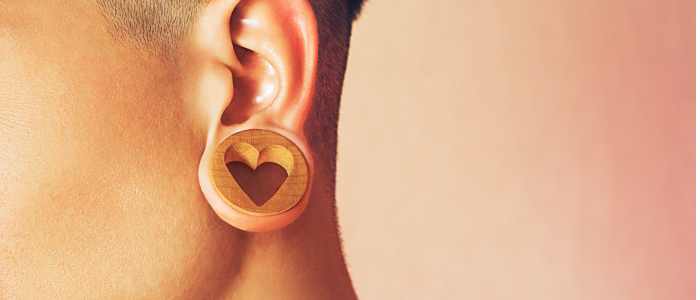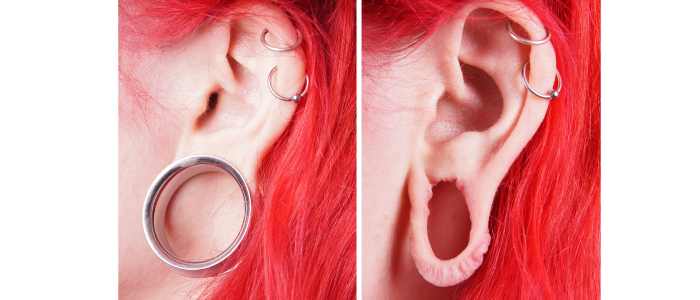
Table of Contents
- How to Fix Torn Earlobes
- What Are Torn Earlobes?
- Types of Torn Earlobes:
- Symptoms and When to Seek Help
- Prevention Tips
- Treatment Options for Torn Earlobes
- Non-surgical Treatments for Split Earlobes
- Surgical Repair Techniques
- Recovery and Aftercare after Torn Earlobes Surgery
- Consultation for Torn Earlobes Surgery
- FAQs about Torn Earlobes Surgery
- Further Reading about Procedures at Cheshire Plastic Surgery
How to Fix Torn Earlobes
Torn earlobes, a seemingly minor yet significantly impactful condition, stand as one of the most common issues addressed in the field of plastic surgery. This problem, often seen as a simple tear or split in the soft tissue of the earlobe, can arise from various causes ranging from the wear of heavy earrings to accidental tugs. The implications of torn earlobes go beyond a mere aesthetic inconvenience; they can profoundly affect an individual’s self-esteem and comfort, leading many to seek corrective solutions.
In this blog, Chester Consultant Plastic Surgeon Anca Breahna aims to explore the details of torn earlobes, offering a guide on prevention, treatment options, and insights into the surgical solutions available through modern plastic surgery practices.
What Are Torn Earlobes?
Torn earlobes refer to a partial or complete split in the earlobe, the soft, fleshy part of the lower ear. This condition varies in severity from small, barely noticeable tears to complete separations that split the earlobe into two distinct parts. While the thought of a torn earlobe might conjure images of traumatic injuries, the reality is that many cases result from everyday activities and habits. Common culprits include the prolonged wear of heavy earrings, which can gradually stretch and ultimately tear the earlobe tissue. Additionally, accidents such as the sudden pulling of an earring by a child or snagging on clothing can lead to immediate tears. Over time, practices like the wearing of gauges, designed to deliberately stretch earlobe piercings, can also result in elongation and weakening of the earlobe tissue, making it more susceptible to tearing.
Types of Torn Earlobes:
Torn earlobes can be broadly categorised into two main types: partial tears and complete splits. Partial tears occur when the earlobe is injured but not entirely separated, leaving a part of the lobe still intact. These tears may not always be readily visible but can cause discomfort and difficulty in wearing earrings. Complete splits, on the other hand, result in the earlobe being divided into two separate pieces, creating a more noticeable and often distressing cosmetic issue.
Another aspect of torn earlobes relates to the deliberate modification of the earlobe through stretching practices, commonly seen with gauged earrings. Over time, this can lead to significantly stretched earlobes that may not return to their original size or shape even after the removal of gauges. In severe cases, this stretching can result in thin, weakened lobes that are prone to tearing under minimal stress.
Symptoms and When to Seek Help
Recognising the symptoms of a torn earlobe early can significantly affect the outcome of any treatment or repair process. The most obvious sign of a torn earlobe is a visible split or tear in the flesh, which can range from a small, painful slit to a complete separation of the earlobe. Before this dramatic manifestation, individuals might notice discomfort or sensitivity around the piercing site, especially when wearing earrings. In cases of partial tears, the earring might not sit correctly, or there may be an elongation of the piercing hole, indicating that the earlobe is under strain and at risk of tearing further.
Swelling, redness, and bleeding are acute signs that accompany a recent tear, necessitating immediate medical attention to prevent infection and ensure proper healing. For those with stretched or gauged earlobes, signs of distress include thinning of the skin, pain, and cracking, which could precede a tear. It is crucial to seek professional advice at the first sign of these symptoms. A plastic surgeon can assess the extent of the damage and recommend the best course of action, whether it be immediate repair or a wait-and-see approach for minor injuries.
Deciding to consult a plastic surgeon is an important step towards healing both the physical and psychological impacts of a torn earlobe. Individuals should consider seeking help if the tear causes discomfort, if there’s a desire to wear earrings again, or if the appearance of the earlobe affects their self-esteem.
Prevention Tips
Preventing torn earlobes is often possible with simple precautions and changes in habits related to earring wear and care. Here are some effective tips to minimise the risk of experiencing this painful and inconvenient condition:
- Wear Light Earrings: Opt for lightweight earrings for daily wear, saving heavier statement pieces for special occasions. Heavy earrings can gradually stretch the piercing over time, increasing the risk of a tear
- Supportive Backings: Utilise supportive earring backings that distribute weight more evenly across the earlobe. This is particularly important for larger or heavier earrings
- Limit Wear Time: Give your earlobes a rest by limiting the amount of time you wear earrings, especially heavy ones. Removing earrings before sleep can prevent accidental tugs or pressure that could lead to tears
- Be Mindful of Children and Pets: Be aware of the risk posed by curious hands or paws. Children and pets can accidentally pull on earrings, causing immediate tears
- Good Hygiene Practices: Keeping your earlobes clean and healthy can prevent infections that might weaken the tissue, making it more susceptible to tears. Regular cleaning of both the ears and earrings can maintain skin integrity
- Regular Inspection: Regularly check your earlobes for signs of stress, such as elongation of the piercing hole or thinning of the earlobe tissue. Early detection can prevent further damage
- Professional Piercing Services: Ensure piercings are done by professionals who can advise on the best placement to avoid weak spots on the earlobe and recommend appropriate aftercare
While accidents can still happen, being proactive about earlobe health can mitigate potential damage and keep your earlobes healthy and intact.
Treatment Options for Torn Earlobes
When it comes to addressing torn earlobes, the field of plastic surgery offers a range of solutions tailored to the severity of the tear and the patient’s aesthetic goals. These options are important for individuals looking to restore both the function and appearance of their earlobes.
Non-surgical Treatments for Split Earlobes
For minor tears or early signs of earlobe distress, non-surgical treatments can sometimes offer a temporary fix or prevent further damage. These might include:
- Topical Treatments: Application of antibiotic ointments to prevent infection in minor tears or after accidental damage. While these don’t repair a tear, they are vital for wound care and preventing complications that could necessitate surgical intervention
- Earring Support Patches: These adhesive patches can be applied to the back of the earlobe to provide additional support for earrings, distributing the weight more evenly and reducing the risk of further tearing. They are particularly useful for individuals with early signs of earlobe stretching but who are not yet candidates for surgery
However, it’s important to note that non-surgical methods are more about prevention and temporary relief rather than permanent solutions for torn earlobes. For complete or significant tears, surgical intervention is often the recommended course of action.
Surgical Repair Techniques
Surgical repair remains the gold standard for treating torn earlobes, with techniques varying based on the extent of the tear and the desired outcome. The procedures are performed under local anaesthesia on an outpatient basis, allowing for a quick return to daily activities with minimal downtime:
- Simple Lobe Repair: For straightforward, clean tears without significant tissue loss, a simple repair procedure can be performed. This involves freshening the edges of the tear and suturing them back together. The goal is to create a smooth, natural-looking earlobe contour once healed
- Complex Repair for Complete Splits: In cases where the earlobe is completely split or where there is significant stretching, the procedure becomes more complex. Anca may need to employ advanced techniques to reshape the earlobe, possibly involving tissue rearrangement or grafting to achieve a natural appearance. This type of repair requires meticulous attention to detail to ensure the earlobe’s final shape is symmetrical and aesthetically pleasing
- Reconstruction Techniques for Stretched or Gauged Earlobes: Reconstructing earlobes that have been deliberately stretched presents unique challenges. The procedure may involve removing the excess stretched skin and then suturing the lobe into a more conventional shape. The objective is to restore the earlobe to a natural-looking appearance, capable of supporting earrings again if desired
Recovery and Aftercare after Torn Earlobes Surgery
Post-operative care is a critical component of the success of earlobe repair surgery. Patients are advised to:
- Follow Wound Care Instructions: Keeping the surgical site clean and applying prescribed ointments to promote healing and reduce the risk of infection
- Avoid Stress on the Earlobes: It’s important to avoid wearing earrings or engaging in activities that could stress the earlobes for a period recommended by Anca, usually several weeks
- Attend Follow-up Visits: These appointments allow Anca to monitor healing and address any concerns promptly
Most patients experience minimal discomfort post-surgery, which can be managed with over-the-counter pain relievers. Stitches are usually removed within a week or two, and many individuals can return to wearing earrings after the earlobes have fully healed, often in about six months, depending on the repair’s extent.
Surgical repair of torn earlobes not only restores the physical integrity of the ear but also plays a significant role in enhancing the patient’s self-confidence and comfort.
Consultation for Torn Earlobes Surgery
When considering surgical repair for a torn earlobe, the initial consultation with a plastic surgeon is a critical step in the journey towards restoration. This meeting is not only an opportunity for the surgeon to evaluate the extent of the damage but also a chance for patients to express their concerns and desired outcomes. Here is what you can expect during this consultation:
- Examination and Evaluation: The consultation begins with a thorough examination of the torn earlobe. The plastic surgeon will assess the severity of the tear, the condition of the surrounding tissue, and any factors that may affect the healing process, such as previous piercings, scar tissue, or infections. For those with stretched or gauged earlobes, the surgeon will evaluate the amount of excess skin and the feasibility of reconstruction to achieve a more traditional earlobe appearance
- Discussion of Goals and Expectations: An essential part of the consultation is understanding the patient’s goals and expectations. Patients should be prepared to discuss why they are seeking repair and what they hope to achieve with the surgery, whether it’s to wear earrings again, restore the earlobe’s natural appearance, or simply to feel more comfortable with their appearance. Anca will explain the realistic outcomes that can be expected from the procedure, including the limitations and potential risks involved
- Recommended Treatment Plan: Based on the examination and the patient’s goals, Anca will recommend a customised treatment plan. This may involve choosing between different surgical techniques, discussing the possibility of re-piercing after healing, and outlining the expected recovery process. Anca will also provide detailed instructions on pre-operative preparation and post-operative care
- Questions and Concerns: The consultation is an opportunity for patients to ask questions and express any concerns they may have about the procedure, recovery, and outcomes. Patients are encouraged to come prepared with a list of questions to ensure they leave feeling informed and confident in their decision to proceed with treatment
FAQs about Torn Earlobes Surgery

How long does the earlobe repair procedure take?
Earlobe repair procedures are typically quick, often completed within 30 to 60 minutes per earlobe, depending on the complexity of the tear and the specific repair technique being used. Simple repairs for minor tears can be done in less time, while more complex reconstructions or treatments for stretched earlobes may take longer.
Is earlobe repair surgery painful?
Patients experience minimal pain during the earlobe repair procedure, as it is performed under local anaesthesia, numbing the area being treated. After the procedure, any discomfort can usually be managed with over-the-counter pain medication. Most patients report feeling more discomfort from the anaesthesia injection than from the repair itself.
What are the risks associated with earlobe repair surgery?
As with any surgical procedure, there are risks involved with earlobe repair, though they are relatively minor. These risks include infection, bleeding, scarring, and the possibility of an allergic reaction to the anaesthesia. When performed by a qualified plastic surgeon, the procedure is considered safe, and complications are rare.
Can I re-pierce my earlobes after repair surgery?
Yes, you can re-pierce your earlobes after they have fully healed from the repair surgery, which usually takes about 6 months. It’s important to consult with Anca about the best timing and placement for re-piercing to avoid damaging the repaired area and to ensure the best cosmetic outcome.
How can I ensure the best possible results from earlobe repair surgery?
To ensure the best possible results, follow Anca’s pre-operative and post-operative care instructions carefully. This includes keeping the surgical area clean, avoiding any trauma or pressure on the repaired earlobes, and attending all scheduled follow-up appointments. Additionally, when re-piercing, choose lightweight earrings and consider using supportive backings to minimise the risk of future damage.
Medical References about Torn Earlobes
- Ear reconstruction – Mayo Clinic
- What You Should Know About Ear Piercing – WebMD
- Ear correction surgery, including ear pinning – NHS
- A Revised Classification and Treatment Algorithm for Acquired Split Earlobe
- The aesthetic repair of complete traumatic cleft earlobe with a three-flap method
Further Reading about Procedures at Cheshire Plastic Surgery
- Read more about Benefits of Lymphatic Massage after Plastic Surgery
- Read more about Options for Eye Bag Surgery
- Read more about Why You Should See a Plastic Surgeon for Minor Skin Surgery, Lumps and Bumps
- Read more about Minimally Invasive Facelift Alternatives
- Read more about What Is the Best Anti-Ageing Wrinkle Treatment
- Read more about Treatments and Solutions for Split Earlobes
- Read more about Treatments and Solutions for Prominent Ears







